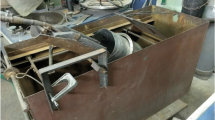Conclusions
Experiments at the Magnezit Plant confirmed the feasibility of drying magnesia refractories with the flue gas in the first positions of a tunnel kiln. Drying the refractories in the section where the flue gas is tapped off does not result in more rejects or in degradation of the properties of the fired products.
Compounding the processes of drying and firing magnesia refractories in a single unit, viz., the tunnel kiln, makes it possible to dispense with the driers the freed floorspace of which can be used for installing equipment for mechanizing the loading of the products on the kiln trucks.
Similar content being viewed by others
Literature cited
A. A. Shumilin, The Drying of Refractories [in Russian], Metallurgizdat, Moscow (1952).
P. S. Mamykin, Refractory Products [in Russian], Metallurgizdat, Sverdlovsk (1955).
Author information
Authors and Affiliations
Additional information
Translated from Ogneupory, No. 4, pp. 15–21, April, 1976.
Rights and permissions
About this article
Cite this article
Tarakanchikov, G.A., Abbakumov, V.G., Ashkinadze, G.S. et al. Drying magnesia refractories with the flue gas of the tunnel kiln. Refractories 17, 211–216 (1976). https://doi.org/10.1007/BF01285180
Issue Date:
DOI: https://doi.org/10.1007/BF01285180




